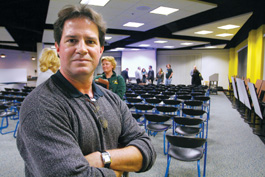home | metro silicon valley index | news | silicon valley | news article

Photograph by Felipe Buitrago
Waiting for answers: Neighbor Mike Bertram wonders how north San Jose can handle 70,000 new residents.
How High Can They Go?
City planners envision an ultramodern north San Jose, but neighbors think the dream city of the future might turn into a nightmare of traffic and high-rises
By Diane Solomon
THE CITY of the future is on course to mushroom in north San Jose between Highways 237 and 880. Over the next 25 years, if all goes according to plan, developers will build homes for 70,000 people and construct industrial parks that will create 80,000 new jobs and keep corporations from off-shoring.
The city's ambitious north San Jose redevelopment project was approved in 2005, and developers have just begun submitting their proposals. But there's no master plan yet, and that worries 5,000 current residents who will soon be sandwiched in by high-rise apartment buildings.
"We've asked the city where the parks, schools, hospitals, fire stations and grocery stores will be, and we haven't gotten answers," says Mike Bertram, representing the River Oaks Neighborhood Association (RONA), formed by people living in modest, two- and three-story town homes on River Oaks Parkway between Zanker Road and Montague Expressway. "We're concerned that they're pushing ahead with development before they've figured out a master plan."
RONA members say they've only found out about the city's plan for their neighborhood piecemeal at outreach meetings held by the developers. So far, Bertram has seen a proposal for three 11-story apartment buildings slated to go right next to his two-story townhome, which sits on a skinny two-lane street.
These neighbors aren't alone in worrying about changes that the "City of the Future" will bring. San Jose has already been sued by Santa Clara County and the cities of Milpitas and Santa Clara for the increased traffic that will spill onto surrounding streets. The case, settled in Superior Court earlier this month, will require San Jose to pay $12.5 million for road improvements and help shoulder the impact on nearby schools.
Roger Barnes of Santa Clara Unified School District says San Jose is building a town of 70,000 people—without schools. "We figure three elementary schools and a small high school will be needed to accommodate the new community," he says.
Meanwhile, the streets in north San Jose are already jammed during commute hours. RONA members say their closest grocery store is two miles away, and they still don't have the parks they were promised years ago when their homes were developed.
City officials finally acknowledged these concerns at a community meeting last week, organized by the persistent RONA group and held at Cadence, one of the corporate complexes on River Oaks Parkway that are going to be turned into high-density housing. More than 100 neighbors filed into the company's brightly lit cafeteria on Tuesday evening and sat in plastic chairs for two hours.
Andrew Crabtree from the Planning Department reassured the crowd that big buildings aren't going to sprout up overnight, saying, "The project is evolving as developers come forward and seek approval for their plans."
It could take 10 years for the first phase of the project to be completed, and there are four phases. Each phase has to meet targets that will balance residential and industrial growth.
Crabtree said that no 11-story apartment towers have been approved and that developers are working under strict density guidelines. There will also be more community meetings and public hearings before the projects go before City Council for final approval.
But will north San Jose's future be realistic? River Oaks residents say they'll need The Jetsons' flying saucers to get around the heavy traffic. City planners say they hope people will stick with light rail, bicycles and walking.
Documented wait times at nearby intersections are already too long. Jim Foran, who's running for the District 4 City Council seat that represents north San Jose, said he gets stuck at the intersection of Montague Expressway and River Oaks Parkway for five minutes during rush hour. Neighbors are still scratching their heads wondering how 70,000 more people will make things better.
Manuel Pineda from the Department of Transportation said the goal is to help people escape the commute by working near their homes. He thinks there will be enough time to work everything out.
"This is a 30-year plan," Pineda said. "If you look at the Environmental Impact Report, the numbers are scary, but it's going to take a long time to develop this area. The phasing [process] will allow housing and business to work together."
Mayor-elect Chuck Reed, one of the masterminds behind north San Jose's future transformation, also fielded questions at the meeting. "This project is a major milestone in city planning for the next 25 years," he said. "It's the key to getting our driving industries to stay here and grow here."
But Reed admitted there's still a lot of work to do. As the mayor, he's going to launch a coordinated effort to work with community members.
"This meeting," he added, "is the start of it."
Send a letter to the editor about this story.
|
|
|
|
|
|